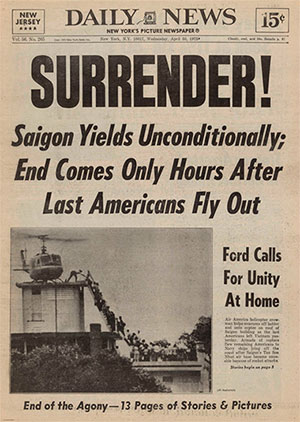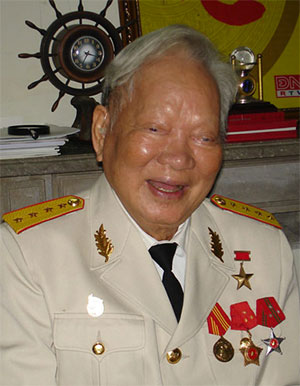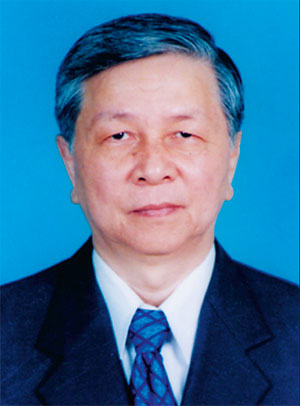
(Blast from the Past, courtesy of the New York Daily News).
This morning marks the end of Black April, forty-two years to the day since Saigon fell to the communists on April 30, 1975. I am not sure if it is correct to use the phrase, given the sensitivity so many of us have with mentioning any hues of the spectrum. But it is what we called it then, and I am going to go with it.
It was not a bad one- we have had so much interesting news lately that a tragedy more than four decades ago only brings back wonder that the events ever happened at all. And with the new trend toward airbrushing our history to meet current fashion, I think it might be worth remembering- at least, those of us that can.
This is also the 22nd anniversary of a day spent with the Mayor of Saigon. I was escorting a Congressional delegation- a CODEL- in an effort to gain cooperation on the search for American missing in action. And perhaps normalize relations with the Socialist Republic of Vietnam. The country was booming on cheap skilled labor, and Uncle Sam was being scooped by a variety of nations, including the once-hated French.

(Former president of the SRV, General Le Duc Anh).
We had been in Hanoi prior to arriving in Ho Chi Minh City, and met with the President of the SRV, Le Duc Ahn, a grandfatherly former general of the Viet Minh and it’s successors. He seemed to be a nice guy, regardless of what he had to do in his war against the French, and later, us.
The Congressman asked him if there was anything he could take back to President Clinton (it feels strange to write those words) that would ease tensions between our nations. We were all surprised when he said, though a translator, that we could change our maps.
We had no idea what he was talking about at first, and thought perhaps he was asking us to change the geopolitical map of Asia, a matter that, in my experience, usually is very expensive and quite violent.
In the matter at hand, it was neither. Our official maps back then were provided and kept current by the Defense Mapping Agency, now part of the National Geospatial Intelligence Agency. The dynamic nature of the world and humankind’s constantly changing activities upon it made textual updates sent by message vital. Diligent aviators and navigators would always go back and check for updates to the basic chart, which was only updated graphically on a periodic production basis. Finding a new chairlift while conducting a low-level training flight can be hazardous to your health.
President Ahn had one of his minions bring one of the offending Jet Navigation Charts (‘JNC’- a favorite, since it shows the broad regional picture) and he pointed to some small words in bolded text adjacent to the SRV. They said plainly “this is a zone of conflict and flight activity could be threatened or attacked.”
The President looked at us and said the insurance companies made everyone dealing with his nation pay steep insurance fees to transit SRV air space, and it was really irritating that the Americans were still claiming the war was going on all those years later.
Well, he had a point. No one had been shot down in a couple decades. The Congressman took the request back to Washington and DMA updated the charts. That was not the cause of normalization, but it was a part of it.
The itinerary had us moving on to Saigon the next afternoon. The Americans at Joint Task Force Full Accounting had a little ceremony before we left, and presented all the members of our delegation with bricks that were salvaged from the Hanoi Hilton, the brutal prison where our captured pilots were held in inhumane conditions and tortured. The French who built it called it the ‘Maison Centrale,’ while the Vietnamese just called it the Hoa Lo Prison. It was being torn down. A small part of it remains, but there were a lot of bricks available in 1995.
The bricks were a touching gift, though that mild satisfaction at acquiring a unique souvenir turned to horror as we went back to the JTF Staff Car that served our local travel needs. One by one, the other members of the delegation turned to me as the escort officer and handed me their bricks for “safekeeping” until we got back to the States. Which was going to be after stops in Burma (Yangon), the PRC, North and South Korea and Japan.
I dragged the wall down to the Rex Hotel in Saigon where we were going to pay a courtesy call on the Mayor, or what they called the Chairman of the People’s Council of Ho Chi Minh City. He was an earnest smiling man named Pham Chanh Truc. We were there on this day, and there was another surprise awaiting.

(Pham Chanh Truc as Mayor of Saigon).
The Congressman slid his arm down where the Mayor could not see his hand and flipped me off after he informed Pham that his military advisor had a speech of congratulations that he (me!) wanted to give on the anniversary of the liberation of the city.
Awkward. I spoke briefly, there were smiles all around while I seethed inside. Interview done, we were leaving the magnificent Hotel de Ville- City Hall- our translator begged the Congressman to get her out of there. She had been to the Fletcher School of diplomacy, and she really preferred living in the good ole USA.
It is a fun story, if you like awkward moments.
In fact, there have been a startling number of awkward military moments to commemorate of late, or perhaps there are too many of us now with too much time on our hands, access to the internet and sea stories to tell. The ones that flashed by in the email strings were ones that resonated strongly. Some of them were about what used to be called “Black April,” the string of stinging military setbacks tat occurred this month in 1975.
“Frequent Wind” was the evacuation of personnel from the capital as mechanized columns of the north advanced for final victory. There was the general consensus that the various anecdotal parts of the history ought to be curated and turned back into prose. I am going to try to collect the digital stream and do that sometime when I have enough time. Which reminds me of Marvel’s great verses in his poem “To His Coy Mistress:”
But at my back I always hear
Time’s wingèd chariot hurrying near;
And yonder all before us lie
Deserts of vast eternity.
The real conclusion of the American War didn’t happen in Saigon, though. The flagship of the U.S. Seventh Fleet USS Oklahoma City (CG-5) had been on station off the coast, supervising the evacuation. She remained there, tying up loose ends until the morning of the 3rd of May. As she turned to depart the coastal waters of Vietnam and proceed to her home part at Yokosuka, a single artillery shell was fired from shore to land a hundred yards astern of the flagship. The shell was not intended to harm the flagship, but rather to extend the middle finger of peace that marked the last shot of the war.
But today is the day we commemorate the blood and treasure that we expended in an effort to stop the spread of Communism. That phrase drips with such irony these days. But the thing I remember the most about the anniversary of Black April is a travel tip. If you are going on an extended trip through Asia, the last thing you want to pack is a brick. Much less enough of them to construct a small masonry structure. The damned things are heavy.
Copyright 2017 Vic Socotra
www.vicsocotra.com
